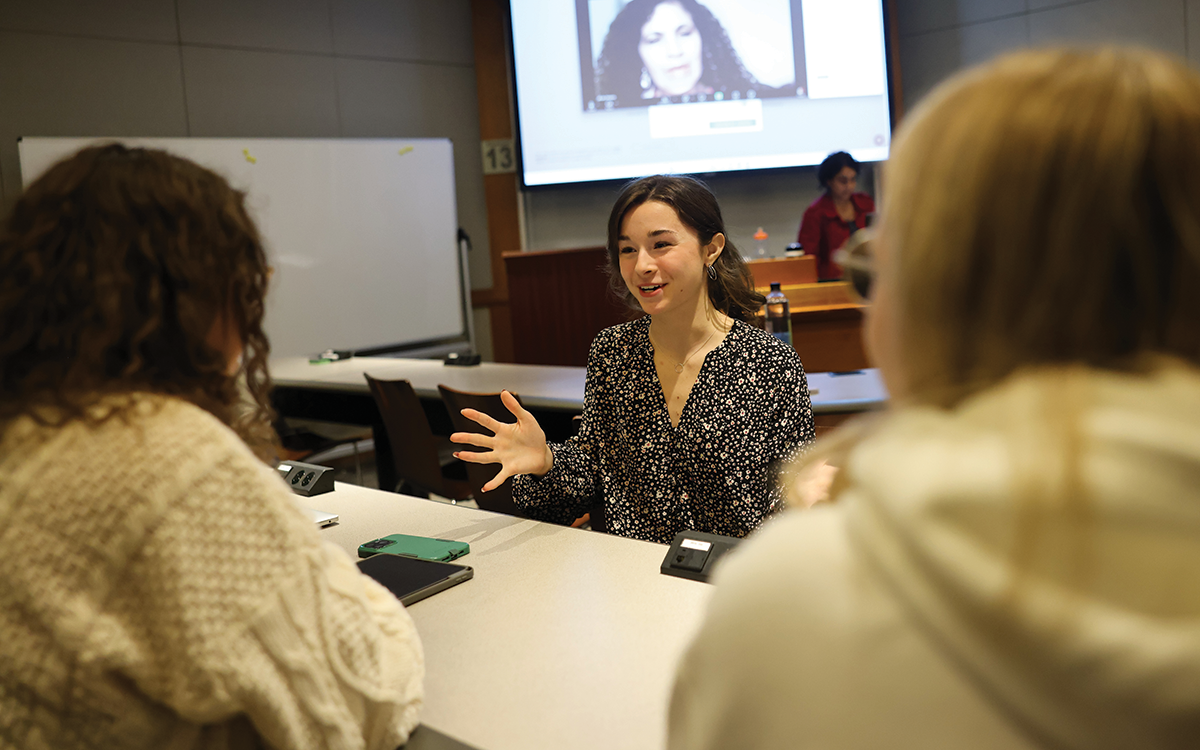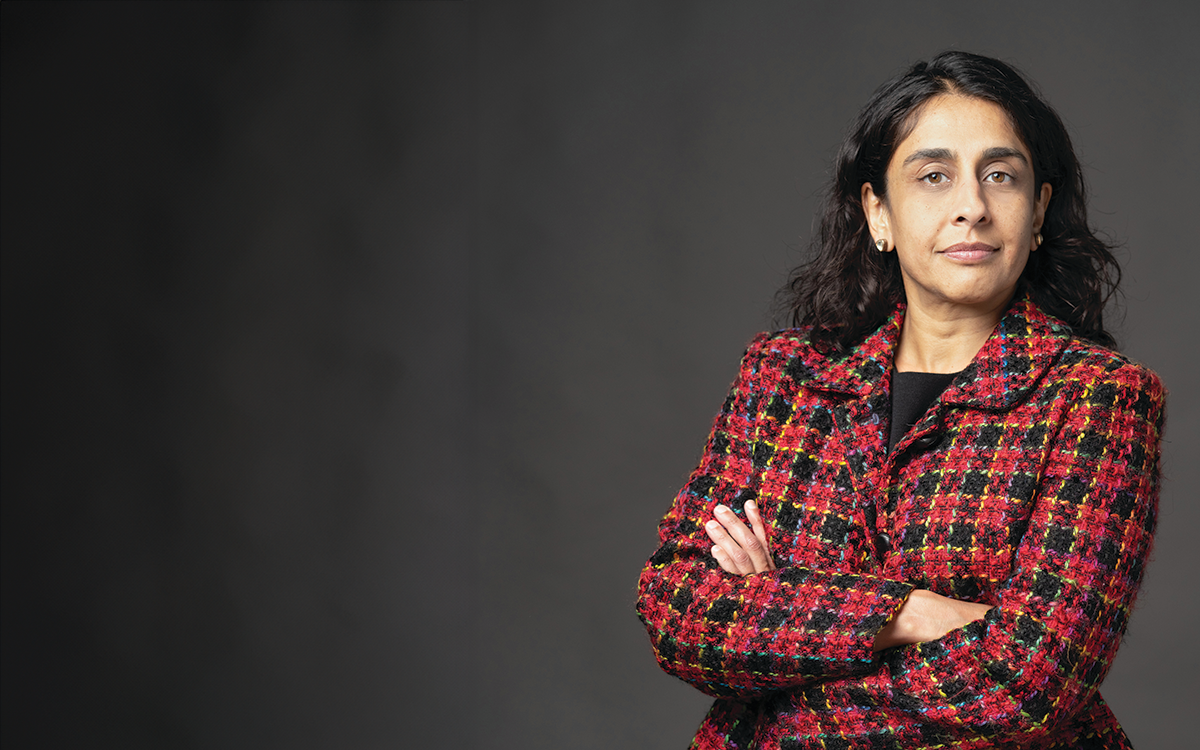feature
There is hope on both sides of the table as clients arrive at Suffolk Law’s Immigrant Justice Clinic’s fall session in New Bedford, Massachusetts. But there are invisible barriers, too.
The Immigrant Justice Clinic provides law students with hands-on experience working on a broad range of issues impacting immigrant communities. Today they are partnering with Centro Comunitario de Trabajadores, an organization that serves New Bedford’s large Mayan Indigenous population, many of whom work in the city’s seafood processing industry. The clinic’s dedicated staff and law students are there to help immigrants apply for work permits. To do so, they must bridge linguistic and cultural gaps while combating confusion, and even distrust, in a complicated legal system.
The vast majority of the clinic’s clients have limited English skills, says Law Professor and Clinic Director Ragini Shah.
At the same time, most of the clinic’s students do not speak Spanish, and while they have access to phone and Zoom translation services, adding layers of technology can feel impersonal (and don’t always reflect regional differences). For Shah, creating an environment that is culturally responsive and welcoming is essential, because “when cultural differences are lost, this could lead to misunderstandings about next steps or losing information needed to build a successful case.”
So today the law students are working alongside three translators from the College of Arts & Sciences (CAS), as part of a semester-long, cross-school pilot program developed by Shah and Spanish Professor Iani Moreno. The undergraduates are there to clarify complex legal forms and make sure clients understand the process. They’re also serving as a critical link between those on two sides of another language divide: law students conversant in legal jargon and clients who largely are not.
Honoring her past, preparing for her future
One of those student-translators knows firsthand how daunting the immigration process can be, and how expensive it is to hire legal help. Marcela De Souza, now a Class of 2027 Spanish and criminal justice double major at Suffolk, emigrated from Brazil five years ago, and she’s grateful for the opportunity to help others through the process by working with the Immigrant Justice Clinic.
“I learned Spanish from different places,” says De Souza, a native Portuguese speaker who picked up both Spanish and English working full-time in restaurants while finishing high school—as well as in the more formal environment of the Boston Debate League’s Spanish-language division, Debate en Español. “One question that came up during preparation was what would we do if a client spoke a dialect or used words we didn’t know?” De Souza says.
So De Souza and her law student partner practiced hard for their day in New Bedford, workshopping different ways to explain terms and concepts so clients with varying backgrounds and language skills could understand. On site, they developed a rhythm for translating the forms from legalese to plain language to Spanish and back again. When they were almost finished, their client, an immigrant from Central America, asked them to be honest: How long would the process really take?
The law student happily informed him that requests of this kind were moving quickly through the system, but De Souza could see doubt creep across their client’s face.
“Eso es lo que me tomó,” she reassured him. “We’re not just being optimistic; that’s how long it took for my paperwork, too.”
Return to Table of Contents
spring 2025
by Andrea Grant
Photography by Michael J. Clarke
Junior Amanda Fagan (left) and sophomore Abigail Morin (right) got a crash course in retail management when they helped open Thrift-o-RAMa, a student-run thrift store located in the Sawyer Building. Photograph by Michael J. Clarke
Law Professor and Clinic Director Ragini Shah:
A new minor in Spanish for professions
To meet the strong demand for employees in the legal, healthcare, and business fields with advanced language skills, this fall Suffolk will launch a new minor called Spanish for the Professions. In preparation, Moreno, director of Suffolk’s Spanish program, spent much of last summer in Mexico immersed in study with lawyers and medical professionals, and she is already teaching a course in Spanish for the health professions. It’s essential, she says, for her students to have real-world translation experiences, and the program will require an internship or service-learning component such as work within the Immigrant Justice Clinic. This will prepare some for roles as translators, but also help those who pursue other careers.
“Many of our students want to become lawyers or doctors, or work in government or global businesses,” explains Moreno. “Learning how to communicate effectively with Spanish-speaking communities—to be both bilingual and bicultural—will help them succeed.”
Shah says the CAS undergraduates did just that, raising thoughtful questions and providing insights the clinic is using to better connect with the communities they serve. “Even though a big part of what I try to train the law students to do is to stay away from legal language, there’s still going to be some things I don’t catch,” she says. “It was really nice to have student interpreters there who would say, ‘Wait a minute, what does that mean?’”
Following the success of the pilot program, Shah is interested in expanding the collaboration to include more students, more languages, and potentially more hours, allowing the undergraduate and law student pairs to work together throughout the yearlong clinic rotation.
During sophomore Ella Ray Creed’s previous assignments as a professional interpreter, the international relations major says she’d felt “more like a computer than a person,” translating strictly what was said and no more. But on that day in New Bedford, she made small talk. It helped the client feel less alienated and more comfortable expressing themselves, she says. And she built a rapport with her law student partner, too, getting a glimpse into the worlds of law school and legal practice.
“I have always considered becoming a legal interpreter, but this experience made me consider law school as well,” says Creed.
For De Souza, working with the Immigrant Justice Clinic was a way to honor her past while preparing for her future.
Giving back is important to her. As a high school student, taking Suffolk and Boston Debate League’s dual-enrollment course helped her envision herself succeeding in college. Now she’s thriving on campus while helping other young debaters through an internship with Debate en Español. After working with Professor Shah and her students, De Souza is considering a career in immigration law.
“We’re translating, but it’s more than that,” says De Souza. “When you’re sitting with a person, you see that they trust you and they share more. I’m able to build that trust by saying, ‘I went through this. I’ve been where you are.’”


“When cultural differences are lost, this could lead to misunderstandings about next steps or losing information needed to build a successful case.”
Psychology undergrads collaborate with the Health Law Clinic to build a successful case
A Winning Team
Sometimes in law, as in sports, deep benches lead to wins. When a client of Suffolk Law’s Health Law Clinic had his application for disability benefits denied, the law students managing his case called in two rookies for an assist.
Under the supervision of Law Professor and Clinic Director Kate Gannon, third-year student attorneys Tiffany Whiles and Chelsea Jones were building a case to show that their client’s genetic condition was causing cognitive issues that require support—but the diagnosis itself was so rare that even reviewers at the Department of Disability Services were unlikely to be familiar with its effects. So they turned to Psychology Professor Sukanya Ray for help strengthening their client’s brief.
As part of the service-learning component for Ray’s Organizational Psychology course, undergraduate psychology majors Chloe Allen, Class of 2027, and Jenna Greenspan, Class of 2026, took on the challenge of researching case studies that could clarify the link between the client’s condition and intellectual disabilities. Shaking off their initial nervousness, the pair pored over scientific literature to prepare a strong, evidence-based case, then presented it to Gannon, Whiles, and Jones.
With their help, the client’s new legal brief was successful without even requiring a formal hearing—a very rare outcome that was a reflection of the students’ hard work, says Gannon. “The client shared with us that he has never felt so supported by a team of people committed to helping him get the services that he needs,” she says.
“I’ve always wanted to help people,” says Greenspan. “This opportunity showed me a different road I could take.”